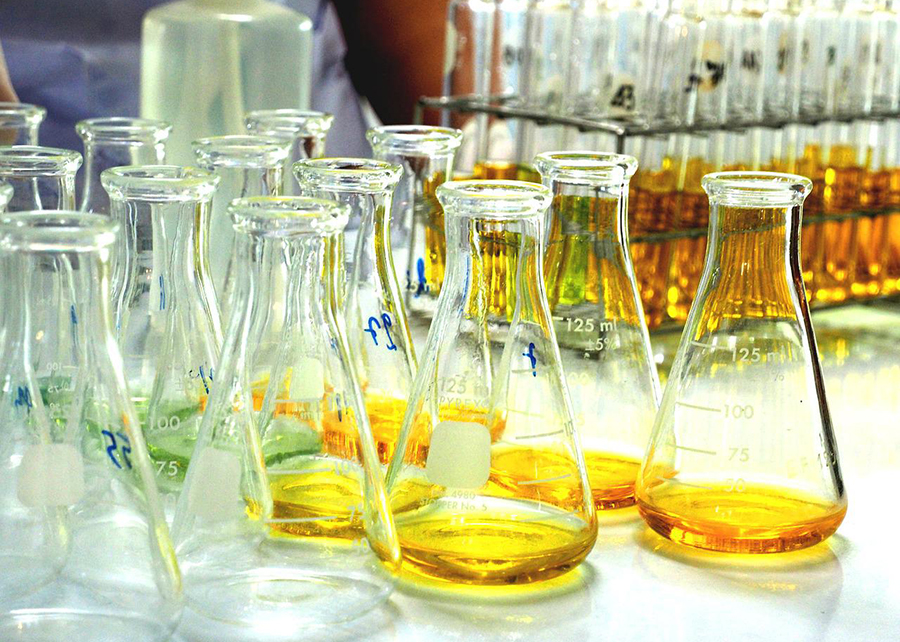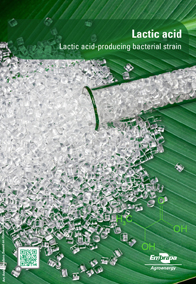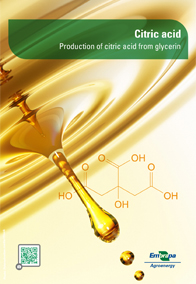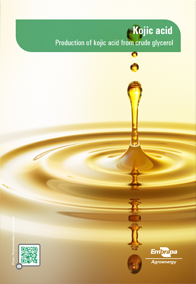Researchers from Embrapa Agroenergy have developed bioprocesses to produce lactic acid, citric acid, xylonic acid and kojic acid, which are widely used in the food industry, chemical industry, cosmetic industry and pharmaceutical industry, as well by as agriculture Through fermentation of renewable raw materials, processes use fungi and bacteria as biocatalysts and are fully sustainable. The new processes require simple adaptations in already existing industrial facilities. Interested companies can participate in the technologies' finalizing stages to bring them to the market. The research team at Embrapa Agroenergy (Brasília, DF) has developed bioprocesses for the production of lactic acid, citric acid, xylonic acid and kojic acid, products of high added value used by the food industry, chemical industry, cosmetic industry and pharmaceutical industry, as well as agriculture. The production of these acids can be made from biodiesel routes or ethanol routes, with renewable raw materials such as glycerin and hydrolysates containing sugars, and uses microorganisms as biological catalysts, composing environmentally sustainable processes. Embrapa seeks partners in the production sector to co-develop the final stages and bring the technologies to market (see table at the end of the text). The production is done through fermentation of different carbon sources such as sugars or glycerin. Each type of acid has used a different microorganism that acted as a biocatalyst for the reaction. For the production of the lactic acid, a strain of bacteria was used. The citric acid and the kojic acids were produced from filamentous fungi and the xylonic acid was produced by genetically modified yeast. The microorganisms used as biocatalysts are part of the Embrapa Agroenergy's collection of microorganisms, which currently has more than 10,000 bacteria, fungi, yeast and microalgae for application in different industrial segments. Advantages "The major advantage we observed in the production of these acids is the use of raw materials from renewable sources and of co-products from biodiesel and ethanol production processes", says researcher Mônica Damaso, responsible for the research. Producing the acids requires simple adjustments to already existing industrial facilities. 'We propose to obtain these products within the concept of sugarcane and glycerol biorefinery, adding value to the energy-sugar-alcohol sector and to the biodiesel sector', Damaso points out. In addition, the nutrients and mineral salts necessary for the growth of the microorganisms responsible for fermentation are already partly found in the raw materials and co-products to be used, which facilitates the process. UN's Sustainable Development Goals Another advantage pointed out by the researcher is the possibility of meeting some of the UN's Sustainable Development Goals (SDGs) through the use of renewable sources of raw materials to obtain bioproducts. The research that originated the lactic acid, citric acid, xylonic acid and kojic acid have adherence to SDG 9 (Industry, Innovation and Infrastructure), as it seeks to promote inclusive and sustainable industrialization and encourage innovation; to SDG 12 (Responsible Consumption and Production), which seeks to ensure sustainable production and consumption patterns; and to SDG 17 (Partnerships for the Goals), as it aims to strengthen the means of implementation and revitalize the global partnership for the planet's sustainable development. Main markets in the industries Organic acids are technological assets that are highly demanded by the industry and can serve different markets, such as the food industry, the fine chemicals industry, and the renewable polymers industry. For lactic acid, the main applications are in the food industry (acidulants) and the fine chemistry industry (paints, varnishes and plasticizers), and the building block market for the manufacture of renewable polymers. For citric acid, the markets with greater applications are the food industry (use as flavor enhancer, growth inhibitor, acidifier, antioxidant, beverage emulsifier and others); the pharmaceutical, cosmetics and personal care industry (use as anticoagulant, moisturizer, emollient, effervescent agent and others). In the case of xylonic acid, its main applications are to fabricate biopesticides, as textile bleach, as a substitute for the gluconic acid used in non-food products, as a cement dispersant, as an antibiotic or as an additive to improve vitamin C absorption. Bacteria helps to obtain Lactic acid Starting from the biodiesel production route, plant oil or animal fat first undergo a process of transesterification, where alcohol and a chemical catalyst are added to the mixture. This process turns the oil into biodiesel and glycerin, which is considered a co-product of biodiesel production. The glycerin then goes through a fermentative process using an isolated Brazilian elite strain of bacteria, which creates the lactic acid as the final product. The research team has also obtained great yields in lactic acid production by using sweet sorghum broth. Citric acid from sugarcane or sweet sorghum If the starting point is the ethanol production route, the process begins with sugarcane or sweet sorghum, a cultivar that can be planted in the sugarcane off-season. After the grinding of the bagasse, a sucrose-rich broth is obtained, which gives rise to citric acid after the fermentation process with microorganisms. The same route can also use fresh sugarcane bagasse which, after pretreatment, gives rise to lignin, cellulose and hemicellulose. These solid materials go through a third step, enzymatic hydrolysis, which creates a sugar that can be fermented and converted into different acids, such as citric acid. Xylonic Acid A third possibility for the use of sugarcane biomass for the production of acids is the fermentation of the sugarcane liquor obtained after the bagasse pretreatment step. The use of recombinant yeast strains Komagataella phaffii (Pichia pastoris) in the fermentation process has generated xylonic acid as a product. It all started with Kojic Acid Acid research at Embrapa Agroenergy began with Kojic Acid from glycerin. Widely used by agriculture and the cosmetics industry, the pharmaceutical industry, the chemical industry and the food industry, kojic acid was obtained by using selected filamentous fungi from the Brazilian biodiversity. Similar to other acids, the production process occurred through fermentative process that had glycerin (crude glycerol), a biodiesel co-product, as its only carbon source. Kojic acid adds value to the biodiesel production chain, increasing its commercial and environmental sustainability. Be a partner of Embrapa Agroenergy Companies interested in any technological asset can partner with Embrapa Agroenergy for technical and scientific cooperation in the co-creation or co-development of products for insertion in the innovation market. The business model adopted is that of open innovation, which allows the cooperation with public and private institutions and companies to co-create or co-develop efficient and sustainable solutions for converting biomass and agro-industrial waste into bioproducts. More information about lactic acid, citric acid, xylonic acid and kojic acid is available at Embrapa Agroenergy's Technology Showcase.
Photo: Pixabay

Organic acids have high added value and are used by the food industry, chemical industry, cosmetic industry and pharmaceutical industry, as well as by agriculture
The research team at Embrapa Agroenergy (Brasília, DF) has developed bioprocesses for the production of lactic acid, citric acid, xylonic acid and kojic acid, products of high added value used by the food industry, chemical industry, cosmetic industry and pharmaceutical industry, as well as agriculture. The production of these acids can be made from biodiesel routes or ethanol routes, with renewable raw materials such as glycerin and hydrolysates containing sugars, and uses microorganisms as biological catalysts, composing environmentally sustainable processes. Embrapa seeks partners in the production sector to co-develop the final stages and bring the technologies to market (see table at the end of the text).
The production is done through fermentation of different carbon sources such as sugars or glycerin. Each type of acid has used a different microorganism that acted as a biocatalyst for the reaction. For the production of the lactic acid, a strain of bacteria was used. The citric acid and the kojic acids were produced from filamentous fungi and the xylonic acid was produced by genetically modified yeast.
The microorganisms used as biocatalysts are part of the Embrapa Agroenergy's collection of microorganisms, which currently has more than 10,000 bacteria, fungi, yeast and microalgae for application in different industrial segments.

Advantages
"The major advantage we observed in the production of these acids is the use of raw materials from renewable sources and of co-products from biodiesel and ethanol production processes", says researcher Mônica Damaso, responsible for the research.
Producing the acids requires simple adjustments to already existing industrial facilities. 'We propose to obtain these products within the concept of sugarcane and glycerol biorefinery, adding value to the energy-sugar-alcohol sector and to the biodiesel sector', Damaso points out. In addition, the nutrients and mineral salts necessary for the growth of the microorganisms responsible for fermentation are already partly found in the raw materials and co-products to be used, which facilitates the process.
UN's Sustainable Development Goals Another advantage pointed out by the researcher is the possibility of meeting some of the UN's Sustainable Development Goals (SDGs) through the use of renewable sources of raw materials to obtain bioproducts. The research that originated the lactic acid, citric acid, xylonic acid and kojic acid have adherence to SDG 9 (Industry, Innovation and Infrastructure), as it seeks to promote inclusive and sustainable industrialization and encourage innovation; to SDG 12 (Responsible Consumption and Production), which seeks to ensure sustainable production and consumption patterns; and to SDG 17 (Partnerships for the Goals), as it aims to strengthen the means of implementation and revitalize the global partnership for the planet's sustainable development. |
Main markets in the industries
Organic acids are technological assets that are highly demanded by the industry and can serve different markets, such as the food industry, the fine chemicals industry, and the renewable polymers industry.
For lactic acid, the main applications are in the food industry (acidulants) and the fine chemistry industry (paints, varnishes and plasticizers), and the building block market for the manufacture of renewable polymers.
For citric acid, the markets with greater applications are the food industry (use as flavor enhancer, growth inhibitor, acidifier, antioxidant, beverage emulsifier and others); the pharmaceutical, cosmetics and personal care industry (use as anticoagulant, moisturizer, emollient, effervescent agent and others).
In the case of xylonic acid, its main applications are to fabricate biopesticides, as textile bleach, as a substitute for the gluconic acid used in non-food products, as a cement dispersant, as an antibiotic or as an additive to improve vitamin C absorption.

Bacteria helps to obtain Lactic acid
Starting from the biodiesel production route, plant oil or animal fat first undergo a process of transesterification, where alcohol and a chemical catalyst are added to the mixture. This process turns the oil into biodiesel and glycerin, which is considered a co-product of biodiesel production.
The glycerin then goes through a fermentative process using an isolated Brazilian elite strain of bacteria, which creates the lactic acid as the final product. The research team has also obtained great yields in lactic acid production by using sweet sorghum broth.

Citric acid from sugarcane or sweet sorghum
If the starting point is the ethanol production route, the process begins with sugarcane or sweet sorghum, a cultivar that can be planted in the sugarcane off-season. After the grinding of the bagasse, a sucrose-rich broth is obtained, which gives rise to citric acid after the fermentation process with microorganisms.
The same route can also use fresh sugarcane bagasse which, after pretreatment, gives rise to lignin, cellulose and hemicellulose. These solid materials go through a third step, enzymatic hydrolysis, which creates a sugar that can be fermented and converted into different acids, such as citric acid.
Xylonic Acid
A third possibility for the use of sugarcane biomass for the production of acids is the fermentation of the sugarcane liquor obtained after the bagasse pretreatment step.
The use of recombinant yeast strains Komagataella phaffii (Pichia pastoris) in the fermentation process has generated xylonic acid as a product.

It all started with Kojic Acid
Acid research at Embrapa Agroenergy began with Kojic Acid from glycerin. Widely used by agriculture and the cosmetics industry, the pharmaceutical industry, the chemical industry and the food industry, kojic acid was obtained by using selected filamentous fungi from the Brazilian biodiversity. Similar to other acids, the production process occurred through fermentative process that had glycerin (crude glycerol), a biodiesel co-product, as its only carbon source.
Kojic acid adds value to the biodiesel production chain, increasing its commercial and environmental sustainability.
| Companies interested in any technological asset can partner with Embrapa Agroenergy for technical and scientific cooperation in the co-creation or co-development of products for insertion in the innovation market.
The business model adopted is that of open innovation, which allows the cooperation with public and private institutions and companies to co-create or co-develop efficient and sustainable solutions for converting biomass and agro-industrial waste into bioproducts. More information about lactic acid, citric acid, xylonic acid and kojic acid is available at Embrapa Agroenergy's Technology Showcase. |
Irene Santana (MTb 11.354/DF)
Embrapa Agroenergy
Press inquiries
agroenergia.imprensa@embrapa.br
Translation: Alessandra Marin, supervised by Mariana Medeiros (13044/DF)
Superintendency of Communications (Sucom)
Further information on the topic
Citizen Attention Service (SAC)
www.embrapa.br/contact-us/sac/





